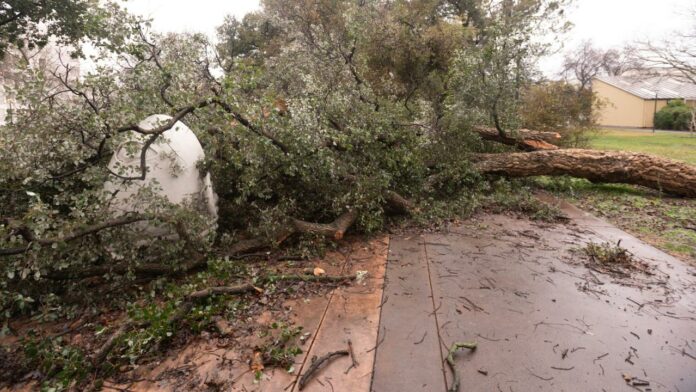Flooding, downed trees affect UC Davis campus as storms continue
By SYDNEY AMESTOY — campus@theaggie.org
The UC Davis campus and surrounding area sustained damage as a result of heavy storms in Northern California throughout the first two weeks of the new year, and cleanup efforts are now underway.
Seventy-four trees had fallen on campus as of Jan. 9, according to Katie Hetrick, the communications director for UC Davis Grounds and Landscape services. A large eucalyptus tree fell and caused damage to Kemper Hall, and three cork oaks came down on Mrak Hall.
“Winds came through the campus from the east, a direction unusual in this area,” Hetrick said. “Our winds usually come from the south, a condition our trees have grown up experiencing and preparing their roots for.”
UC Davis Grounds and Landscape Services, in collaboration with groundskeepers for the Arboretum and Putah Creek Riparian Reserve, are currently leading the cleanup efforts across campus. According to Hetrick, this effort will likely take months to complete.
“Clearing efforts are happening simultaneously [with the storms],” Hetrick said. “Before the majority of students arrived back on campus, downed trees and large messes of debris were cleared from student housing areas, major pathways and storm drains. But the overall cleanup effort is going to take months and will include irrigation system restoration where uprooted trees have damaged infrastructure and landscape renovations.”
Minor flooding in parts of the Arboretum did occur, according to Hetrick, but there was not any significant damage to the area because groundskeeping teams prioritized clearing storm drains of debris during and after storms.
According to a recent UC Davis press release, many student residence halls lost power sporadically during the first couple weeks of January, including all of the Cuarto buildings. The Green also experienced power outages and some smaller downed trees, but no other major damage, according to The Green’s Director Marshall Walters.
“One of our buildings lost power on two separate occasions, for about 15 hours each occurrence,” Walters said. “The electricity outage, in turn, caused residents to lose hot water, WiFi and power to the exterior doors.”
Power has since been restored to all residence halls as well as at The Green, according to the release. Hetrick said that campus facilities largely retained power throughout the storms because their power lines run underground and are therefore protected from the risk of falling trees.
Despite not losing power at any point during the storms, the Memorial Union (MU) did experience some water damage as a result of the rain.
“We did have spots of isolated leaking in the east hallway, the Coffee House dining [area] and by the door leading to the MU South Patio,” Janna Tolla, the director of the MU, said. “[We] will therefore need ceiling tiles replaced and likely some patches sealed up on the roof.”
According to Tolla, the MU weathered the storm well in part due to preventative measures taken to clear leaves from its drains and gutters during fall quarter by Facilities Management.
“I can’t emphasize how much we rely on them and how thankful I am that they were here in between storms to care for campus and the Memorial Union,” Tolla said.
Over the past few years, the UC Davis Campus Planning office and the Arboretum and Public Garden team have jointly created a long-term plan known as the UC Davis Living Landscape Adaptation Plan (LLAP) to help prepare campus landscaping for extreme weather events and environmental changes in the future, according to Hetrick.
“Students in the Arboretum and Public Garden’s Learning by Leading program are already at the center for many of these efforts, including helping with the planting of 200 trees last year,” Hetrick said.
According to the Arboretum website, the LLAP includes “strategies to transition our tree canopy, enhance the biodiversity of our landscapes [and] secure sustainable water sources.” Hetrick said that this plan was created with extreme weather events like the ones the past few weeks in mind.
Written by: Sydney Amestoy — campus@theaggie.org





